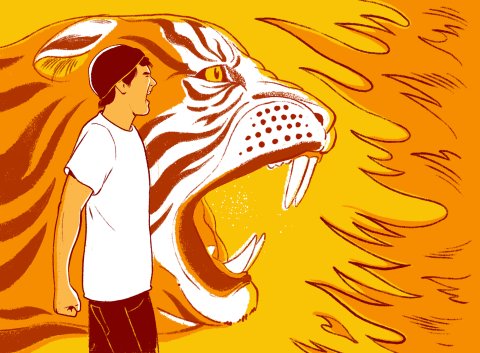Teenagers are notorious risk-takers, and the outrageous, unpredictable things they do—from extreme sports to binge-drinking—can seem inexplicable to the adults around them. Are they driven by rebellion, poor judgment or immature brains? In this excerpt from their book Wildhood, the bestselling authors of Zoobiquity, Barbara Natterson-Horowitz and Kathryn Bowers, present findings from their five-year study on wild animal adolescence. They uncovered evidence that young folks are hardwired to take risks—and with good reason. Across the animal kingdom, risky behavior helps adolescents develop into safer and more confident adults. Can understanding the animal basis of a human teenager's behavior help a parent balance the urge to protect with the need to develop independence?
Vulnerable by Nature
Adolescent humans suffer much higher rates of traumatic injury and death compared to adults. Around the world, the risk of dying skyrockets between childhood and adulthood. Accidents from car crashes, gunfire, falls, drownings and poisonings are the leading causes of death for this age.
Adolescents drive faster than adults and buckle up less often. They have the highest rates of criminal behavior and are five times more likely to be the victims of homicide than adults 35 or older. Except for toddlers (who stick fingers into sockets) and adults with jobs in electricity-related industries, adolescents have the highest rates of fatal electrocution. Compared with other populations, their suicide numbers are high—as are mental illnesses and addictions. And adolescents are far more likely to binge-drink themselves to intoxication and death than older adults.
We performed a comprehensive survey of age-related mortality in wild animals and found something truly startling. Life on Earth for adolescent and young adult animals is just as dangerous. In the wild they crash, drown and starve more often than their adult counterparts. With less experience, they're pushed into jeopardy by older, bigger peers. They're preferentially targeted and killed by predators.
They are, to put it bluntly, easy prey.
From Predator Naive to Predator Aware
Every year, thousands of adolescent king penguins leave the nest and plunge into the predator-filled waters around Antarctica. Some years, half of them don't make it out alive, the victims of leopard seals, killer whales and starvation. Other years are less deadly, but no matter what, the first days, weeks and months after fledging are exceedingly risky for all penguins.
Old enough to be away from home, but new to the ways of the world, this time of life is risky for human adolescents as well. Fortunately, adolescent mortality isn't quite as high for human beings as it is for penguins. But across the animal kingdom, adolescents share a characteristic that places them in mortal danger: inexperience. Wildlife biologists describe these unprepared, unsuspecting young animals as "predator naive."
Predator-naive groundhogs cavort obliviously even when coyotes are nearby. Predator-naive adolescent sea otters will recklessly swim toward, instead of away from great white sharks.
Predator naive is exactly what human adolescents are, too, when they enter the world with little experience. A predator-naive teen going off to a party or a young adult moving to a new city won't have coyotes or sharks waiting, but the array of dangers they may face are no less lethal: a swerving truck, a drunken hazing ritual, a depressive episode or a predatory adult.
Facing mortal danger while still maturing is a fact of life for adolescents and young adults across species. Adolescents must become predator aware if they are to survive. It's a paradox: to become experienced, you must have experiences. Said another way: To become safe, you must take risks. And notably, some risks can't be taken—and their lessons learned—when protective parents are hovering nearby.
Parents can't always protect their kids, especially when they're physically apart. And the risky behaviors many adolescents are drawn to—including reckless driving, substance abuse, careless sex—baffle adults, for whom avoiding accidents seems far more logical than inviting danger to come closer.
It may be helpful to distinguish between risky situations teens seek out and the naivete that makes them targets. Both, when survived, can offer future protective benefits. Taking risks to become safe is not a paradox. It's actually a requirement for adolescent and young adult animals on Earth.

Predator Inspection
Why would animals ever behave in ways that endanger their lives? Risk behaviors in adolescents who haven't reproduced seems to make little evolutionary sense. Yet our study of one dangerous behavior common among wild animals showed not only its benefits, but its essential purpose.
Adult bats typically flee predators such as barn owls. But adolescent bats have been seen doing the opposite. They fly toward them. If we saw this in human adolescents, we might think they were thrill-seekers. However, as scientists from a Smithsonian Tropical Research Station in Panama observed, these bats weren't the animal version of knuckleheads chasing an adrenaline buzz. The young bats didn't know it, but they were doing something extremely important for their future.
Biologists call it "predator inspection." This colorful term describes a behavior seen in wild adolescent fish, birds and mammals when they approach—instead of flee—danger. Predator inspection provides naive young animals crucial information about their lethal predators. Familiarity with predatory strategies helps adolescents survive and even avoid future attacks. Predator inspection is one of the ways adolescents transform from predator naive to predator aware. And they're driven to do it by the hormonal and brain changes of adolescence. All animal brains—including, of course, our human ones—deliver pleasurable chemical rewards for behaviors that increase survival. But the brains of adolescent animals deliver extra-pleasurable rewards for critically important safety learning like predator inspection.
There are many reasons why teens get fake IDs and sneak out in the middle of the night to go to bars and nightclubs. But our research identified a central driving factor. Across the animal kingdom, adolescents are drawn to danger. We found that these encounters, if survived, make adolescents safer and even more confident. Similarly, human teenage fascination with the forbidden may be an ancestral drive to come face-to-face with the very predators they've been warned about. Across species, the key is to gain the educational benefits of a brush with death—minus the death.
READ MORE: How Two Authors Changed Their Parenting Styles After Studying Animals in the Wild
The heightened pleasure adolescent brains receive from bursts of fear explains why the vast majority of horror film audiences and roller coaster lines are made up of adolescents. Young Adult (YA) fiction focusing on death by drug addiction, cancer, terror and gunshot allows individual readers to experience these life-threatening risks without physical harm. True-crime podcasts like My Favorite Murder owe much of their record-breaking popularity to the evolutionary legacy of predator inspection.
Studying wild animal adolescence offers a new understanding of why teenagers act the way they do. For parents balancing the urge to protect with the need to let their teenagers test their wings, it can be a guide. Erring on the side of caution is generally the safest advice. But inexperience has its own perils. Our research suggests that adolescents need some exposure to the dangers they will someday face on their own—and without knowing that, a parent's overprotection may be the riskiest behavior of all.
→ Excerpt adapted from Wildhood: The Epic Journey from Adolescence to Adulthood in Humans and Other Animals by Barbara Natterson-Horowitz and Kathryn Bowers, published by Scribner.











